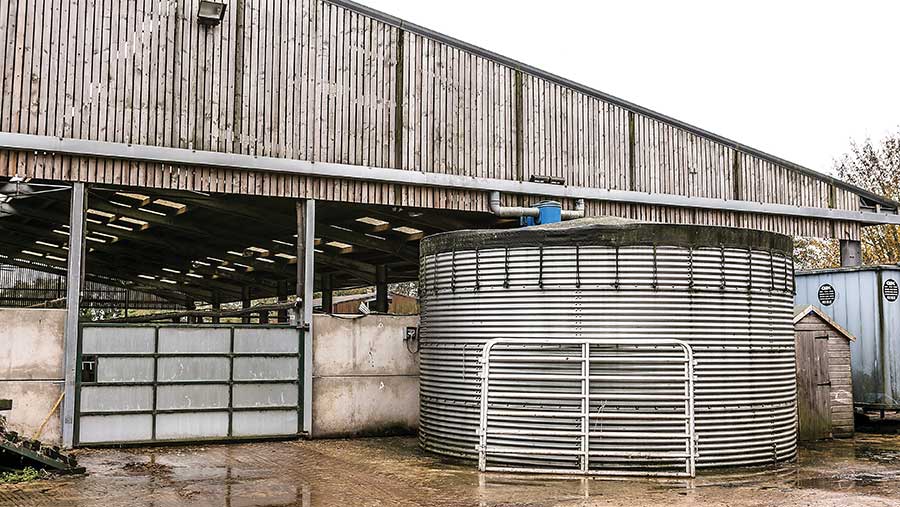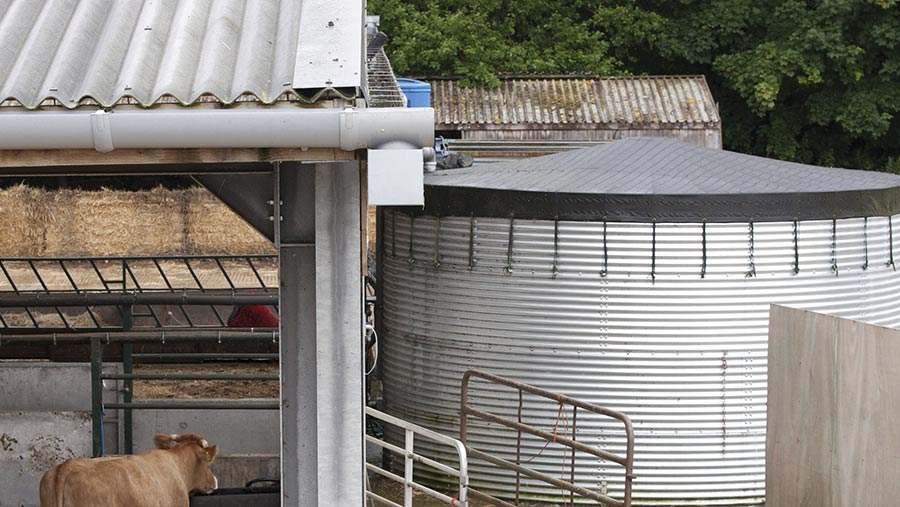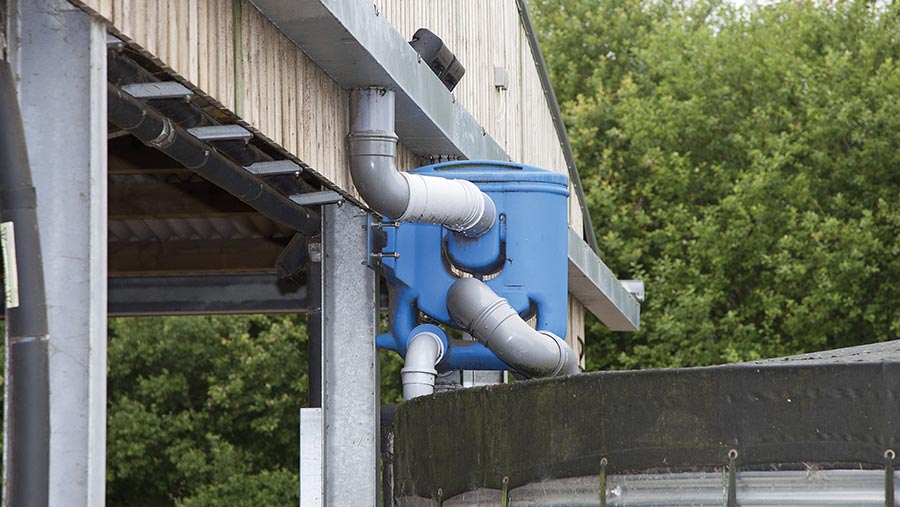A guide on how to harvest rainwater on a farm
 © Richard Stanton
© Richard Stanton Livestock farms can use large amounts of water, with one study by Adas suggesting dairy farms spend £31-£100 a cow a year on water.
It may be a worthwhile investment to harvest rainwater to cut down on water bills. Rainwater harvesting can be used in all livestock sectors where there are buildings to collect water.
There are lots of different rainwater-harvesting systems available for farms, which can:
- minimise the environmental impact on the farm
- and reduce the amount of water entering the slurry pit by up to 30%.
These setups range from DIY systems through to more expensive plug-and-play kits.
Some will have filtration systems and pumps, whereas others will rely on gravity to feed the water.
Livestock consultant Neil Rowe gives some advice on factors to consider if you are installing equipment.
See also: Top tips for how to take on dangerous job of mixing slurry
1. Weigh up return on investment
Any livestock unit that houses stock or uses large amounts of water could gain from installing a rainwater harvest (RWH) system. The main benefit is that it can reduce the cost of water. Typically, charges for mains water are £1-£2/cu m.
Using rainwater harvesting for some or all water on farm could reduce bills. However, the intended use will determine any savings that can be made. For example, the costs of pumping mains water around the farm is included in the water bill already.

© Richard Stanton
If you have to pump rainwater around the farm, this has to be considered. Any savings also have to be offset against the capital and operational outlay for rainwater-harvesting equipment.
The return on investment will be influenced by
- Amount of rain
High-rainfall areas have greater potential. - Type of roof, area and slope
Factors such as downpipe numbers will influence the efficiency of gathering water. Water will be lost with too few downpipes or an insufficient gutter system. - Ease of installation
Rainwater harvesting can be viewed favourably by planners on greenfield dairy projects. For example, a rainwater-harvesting system is easier to install on a new unit with the correct amount of downpipes. - Existing water use efficiency
It would be worth getting any water leaks fixed before investing in rainwater-harvesting kit. - How much water is being used and where
Review old water bills for annual use and see how and where water is used.
2. Calculate potential
Do a simple calculation on the amount of water that can be harvested by installing a rainwater-harvesting system using this formula:
Potential collectable rainfall (litres) = roof area (sq m) x run-off co-efficient* x filter efficiency factor** x annual rainfall (mm)
* Run-off co-efficient estimates water flow off the roof surface and quantities lost. A co-efficient value of 0 would mean no run-off occur, while a value of 1 would see all rainfall run off.
Common roof co-efficients (ecosystems)
|
|
| Roof type | Co-efficient |
| Pitched roof | 0.85 |
| Flat roof smooth surface | 0.55 |
| Flat roof with gravel layer or thin turf | 0.45 |
** Filter efficiency: Rainwater collection filters will often reject the first flush from the roof to prevent debris entering the tank. Filter efficiencies are often available from rainwater-harvesting component suppliers. However, if this isn’t possible, an efficiency factor of 0.80 (80% efficiency) should be used.
3. Choose a system
Rainwater-harvesting systems can range anywhere from a few hundred pounds to £35,000 on some large units. It will depend on the amount of storage, whether storage is above or below ground, the filters and pumps.
Pros and cons of above- and below-ground storage systems
|
|||
| Storage type | Examples | Pros | Cons |
| Above-ground | Large purpose-built tank/disused milking tanker/recycled containers |
Ease of inspection Ease of repair and maintenance of the tank and equipment Lighter and less expensive construction Easier to add or increase capacity Lower installation cost Cheaper than other systems – using a recycle IBC container holding 1cu m of water costs about £70 for the storage |
Risk of frost Occupies ground space Requires a cover More susceptible to algal growth and poor water quality Requires a tank specifically designed for use above ground |
| Underground tanks |
Helps to prevent algal growth by shielding the tank from daylight Protects the tank from extreme weather Helps to regulate the water temperature in the tank, keeping it cool and limiting bacterial growth Saves space |
Additional cost of excavation and installation Less accessible for inspection and maintenance Tend to be more expensive |
|
| Source: Environment Agency | |||
Pumps
Indirectly pumped systems
Rainwater is stored in a tank, then pumped to a header tank and delivered to appliances via gravity.
Advantages: If the pump fails, water is still supplied through the mains top-up function. They are cheaper, more energy-efficient and simple to use. However, pressure is often lower.
Directly pumped system
Pressurised system where rainwater is collected and stored in a tank or reservoir, then pumped to the point of use on demand.
Normally a mains or abstraction supply option maintains a minimum level capable of meeting short-term demand. Water is supplied at pressure and no header tank is required.
However, pump failures mean water cannot be supplied.

© Richard Stanton
Gravity-fed systems
Rainwater is collected from the roof, filtered and piped by gravity to a header tank.
Water is delivered to appliances via gravity. Mains top-up water can also be fitted. This doesn’t require a plump or electricity supply. However, water pressure will be low and pressure pumps may be required.
Filters
The filter system is important, as the risk of spreading disease through contaminated water can be high. A mesh filter to catch any objects such as leaves or roof deposits is the minimum requirement.
These range from less than £100 for a simple mesh to more than £2,000 for filters that split water and automatically self-clean the mesh.
However, to avoid any contamination, water should be passed through a UV filter for animal drinking water or parlour washing.
The cost of UV units depends on flow rates and they typically range from £360 (8 litres/minute) up to £710 (54 litres/minute).
It is also advisable to install a system that avoids taking water from the bottom 0.6m of the tank and the top 0.3m, because this is where any toxins are most likely to lie.
To achieve this, it is possible to have mains water entering the tank via a fixed pipe with a ball valve inside the tank. This means mains water will not drop below a certain level.
A floating outlet pipe will also prevent water being sucked up from the bottom. A mesh filter should be installed to prevent any debris blocking the pipes.
Testing water for toxins from the presence of E coli is advisable. A liquid mineral system and purifier bolted on to the outflow is another consideration.
This would allow water troughs to be targeted with the exact minerals and would remove any taints in the water that could hinder intakes.
4. Regulation
Dairy hygiene regulations require that any water used for hand, udder or dairy plant washing must be from a potable source.
If this is not a mains supply, the water needs to be tested annually by a local Environmental Health officer.
- The Red Tractor Assurance scheme requires water for drinking to be “fresh and clean”
- Water supply (water fittings) regulations 1999 must be complied with on all premises with mains supply
Pipes carrying non-potable water should also be clearly identified.
Grants
Grants are available for equipment such as UV filters for rainwater under the Countryside Productivity Small Grant Scheme. However, the current funding round is closed. Read more on the government’s website.
